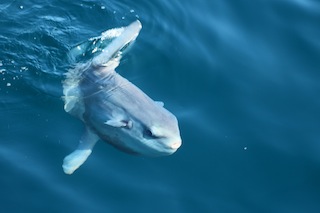 The warm weather of summer brings Ocean Sunfish to seas around the Lizard.
The warm weather of summer brings Ocean Sunfish to seas around the Lizard.
Photo: Amanda Scott
Scientific name: Mola mola
Other common names: Common Mola. In various European languages its name translates as ‘Moonfish’, and as ‘Swimming Head’ in German.
Conservation status: Not yet classified by the IUCN.
 The average weight of an adult Ocean Sunfish is 1,000 kg: this is the world’s heaviest known bony fish. Found in tropical and temperate waters across the globe, it is an unusual looking creature. For one thing, it does not have scales, but instead has a tough, mucus-covered, silvery- to brownish-coloured skin. The caudal fin (i.e. the tail fin) has evolved to become a short ‘pseudo-tail’ (the cadus), creating the effect of a large round fish head with fins. The dorsal and anal fins (on the top and bottom of its body, respectively) are long, and combined can be as long as its head-to-tail measurement (around 2 to 3 m for a mature adult): they are used to propel the fish when swimming.
The average weight of an adult Ocean Sunfish is 1,000 kg: this is the world’s heaviest known bony fish. Found in tropical and temperate waters across the globe, it is an unusual looking creature. For one thing, it does not have scales, but instead has a tough, mucus-covered, silvery- to brownish-coloured skin. The caudal fin (i.e. the tail fin) has evolved to become a short ‘pseudo-tail’ (the cadus), creating the effect of a large round fish head with fins. The dorsal and anal fins (on the top and bottom of its body, respectively) are long, and combined can be as long as its head-to-tail measurement (around 2 to 3 m for a mature adult): they are used to propel the fish when swimming.
Sunfish cannot survive for long in water temperatures of below 12ºC, and are therefore visitors to British southern coastal seas in warmer seasons. They spend periods swimming at depths of a few hundred metres, but are known for their characteristic basking at the sea surface, lying on their side, probably to expose as much surface area as possible to the sun and/or to reoxygenate. They often wave their fins at the same time, and there is also a theory that they exhibit this behaviour in order to attract seabirds to cleanse their skin of the many parasites they are known to carry.
Jellyfish are the main diet of Ocean Sunfish, of which they consume a large amount, as well as some smaller fish and crustaceans. In turn, Sunfish are predated by seals, sharks and orcas. They are not an aggressive species and pose little or no threat to humans.
Sunfish are a major fisheries bycatch in the Pacific, Atlantic and Mediterranean. This is therefore perhaps the major threat to their populations, in particular as there are significant gaps in our knowledge of their biology and distribution patterns, meaning the impact of fisheries-related activity on Sunfish is difficult to assess.
Did you know…?
…The fish’s Latin name, mola, is derived from the Latin word for ‘millstone’ because of its flattened, round and grey appearance.
…Female Ocean Sunfish carry more eggs in their ovaries (up to 300 million) than any other vertebrate species. The new hatchlings are tiny, at about 0.25 cm in length.
Published: September 2013
Author: Amanda Scott
Photos: Amanda Scott
